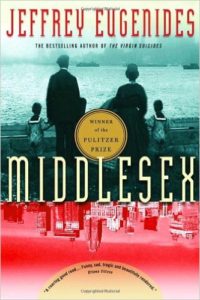

“Like its hermaphroditic narrator, Jeffrey Eugenides’s long-awaited second novel is a hybrid—it’s at once a Greek-American family saga and a picaresque coming-of-age narrative. Whereas the author’s first book, The Virgin Suicides (1993), was closely woven, Middlesex is long and episodic, reaching back across the twentieth century and bringing in dozens of characters. Yet the organization is simple. Calliope Helen Stephanides—now the forty-one-year-old male narrator, Cal—tells us how he came to switch sexual identities; how he kept his secret; and what happens once his true nature is exposed.
Middlesex is consistently whimsical in its scene-setting and use of language, but despite its vaudeville exchanges and niftily isolated punch lines, it’s rarely out-and-out funny. The narration is baldly self-conscious in its cleverness. In the beginning Cal refers to his brother as Chapter Eleven, and throughout the first half he interrupts the story to give us portentous glimpses of coming events. Likewise, and also in the manner of the picaresque, the author takes advantage of his loose structure and has the narrator recap in spots what’s happened so far, as if, in all the commotion, we might have forgotten.

The reader spends much of the first half of the book anticipating the birth of its hero, yet when Calliope finally arrives, her early childhood flies by, warranting less than a dozen pages (which gloss over the question of why her mother didn’t discover her secret while changing or bathing her). At this point, having established a historical sweep across several generations, the book noticeably shifts gears. The final two hundred pages focus on just a couple of years of Calliope’s adolescence, giving Eugenides a chance to revisit the world of Grosse Pointe, Michigan, that he sketched so brilliantly in The Virgin Suicides.
Perhaps this is the author’s true home territory, because it’s here, in Calliope’s sexual awakening, in the tensions of innocent and helpless desire, that Middlesex is at its best. At her private girls’ school Calliope falls in love with another student, whom Cal calls The Object, and their teenage romance, with all its Nixon-era trappings, leads—through a series of improbable events—to her unmasking. The tail end of the book, covering her testing at the hands of a pop sexpert, her choice to become Cal, and a brief dip into the underworld of porn, is anticlimactic, though line-by-line the writing is always jaunty and sharp.

The action stops in 1975, with the now male Cal in contemporary Berlin. Throughout the book, in the briefest of vignettes, he’s been trying to romance a photographer named Julie while paralyzed by fear of disclosing his true nature; but this is so undeveloped compared with the other sections that the reader never feels it fully. And such problems plague the whole novel: it’s off proportionally, both section-to-section and overall, its two halves at odds, each interesting at times but neither truly satisfying, despite Eugenides’s prodigious talent. Like Cal, it’s damned by its own abundance, not quite sure what it wants to be.”
–Stewart O’Nan, The Atlantic, September, 2002

